Biodiversity
Targets for Biodiversity Conservation Activities
Meiji Group 2026 Medium-Term Management Plan
- Data target range or company leading initiatives
- 1, 2: Meiji Group (consolidated) (Japan only)
| Major initiatives | Metrics | Results | Targets | |
|---|---|---|---|---|
| FYE March 2025 | FYE March 2027 | |||
| 1 | Promote certification registration as a Site in Harmony with Nature | Number of newly certified areas | 0 | 1 new registration (total of 2) |
| 2 | Conclude maintenance management agreements to engage in forest conservation activities | Forest area under maintenance management agreements | 15ha | 40ha or more |
| 3 | Analysis and formulation of countermeasures aligned with the TNFD framework for raw milk and cocoa Promote initiatives to reduce deforestation of major raw materials such as cocoa and palm oil | For KPI, use the same as initiatives to achieve zero deforestation in cocoa beans and palm oil under "Human rights and environmentally friendly raw material procurement" | ||
Approach to Biodiversity
Due to the world's economic activities, we are facing a critical situation amid a rapid loss of biodiversity caused by disruption of habitats by deforestation and deterioration in habitat environments, including environmental pollution. As the businesses of the Meiji Group depend on the abundant gifts of nature, including raw milk, cocoa and lactobacillus, and microorganisms used for developing antibiotics, we recognize that loss of biodiversity is a significant social issue. We identify the impact and dependency of our business activities on biodiversity throughout the entire supply chain, from raw material procurement to waste disposal, preserving and regenerating biodiversity to ensure that we enjoy the abundant gifts of nature for years to come. We comply with treaties, laws and regulations related to biodiversity, and contribute to the creation of a society that coexists in harmony with nature.
Biodiversity Conservation Activities Policy
In March 2024, we revised the Meiji Group Biodiversity Conservation Activity Policy. In addition, we established the Meiji Group Nature Positive Declaration. Amid ongoing loss of biodiversity, we intend to contribute to the creation of a society that coexists in harmony with nature throughout the entire supply chain, from raw material procurement to waste disposal.
Relationship between Our Business Activities and Biodiversity
The Meiji Group is deeply involved in a variety of biological resources and ecosystems through our food and pharmaceutical businesses, and it has an impact on biodiversity throughout our entire supply chain, from raw material procurement to waste disposal. Based on this recognition, we pursue biodiversity-friendly activities, reduction in impact on biodiversity, effective use of biological resources and enhanced understanding of biodiversity among our employees.
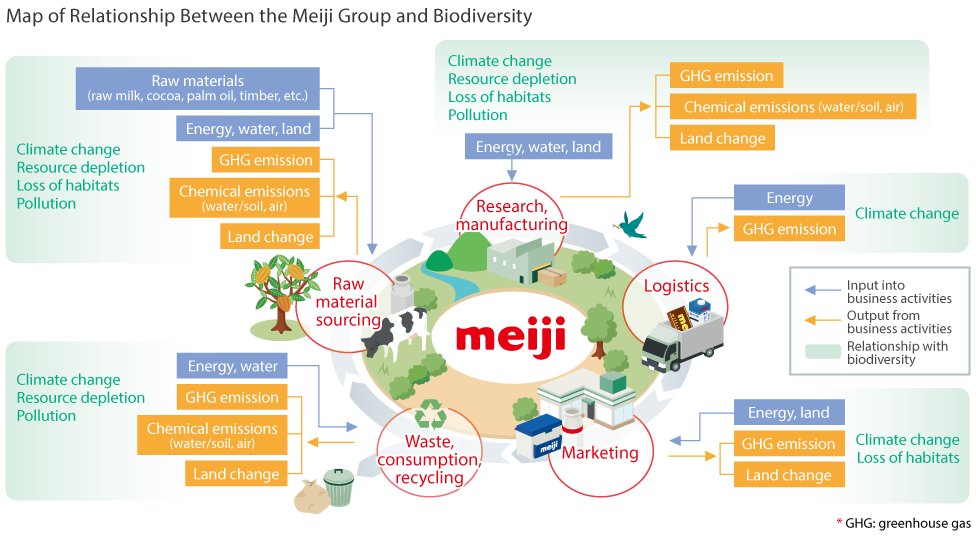
Collaboration with UN agencies and related organizations
To promoting biodiversity conservation, collaboration with various stakeholders is necessary. Meiji Group is strengthening our collaboration with external organizations to grasp the environmental impact of our business activities and implement concrete measures to resolve these issues.
- - Japan Business Initiative for Biodiversity (JBIB)
- - Taskforce on Nature-related Financial Disclosures (TNFD) Forum
- - Keidanren Committee on Nature Conservation
Protect Local Biodiversity
Effect of Business Activities on Biodiversity
Environmental Risks Related to the Meiji Group’s Business Activities
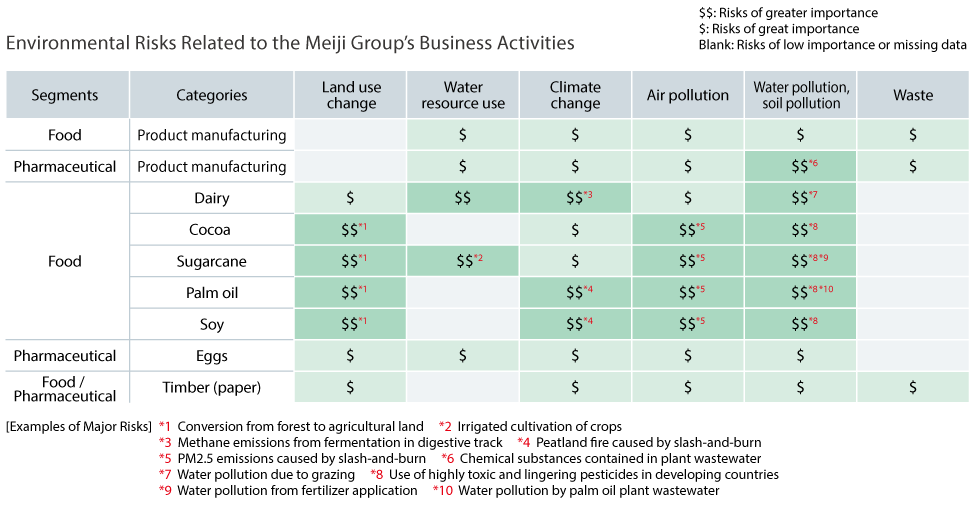
Impact of Water Risks on Yields of Main Raw Materials
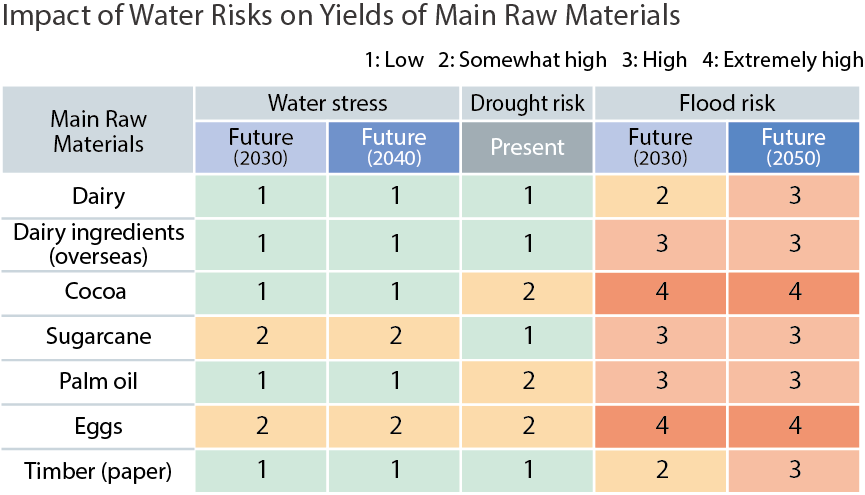
Biodiversity risk assessments for land owned by the Meiji Group
We assessed the dependence and impact on nature related to the Meiji Group-owned land from the standpoint of business continuity. For the 61 company-owned production sites we investigated various risks using the WWF Biodiversity Risk Filter (WWF Biodiversity Risk Filter)1. For company-owned production bases, the physical risk2 of company production sites scored higher than reputational risk3, making physical risk which type demanding greater attention. In terms of physical risks related to company-owned production bases, the risk of exposure to natural disasters due to damage to biodiversity (landslides, wildfire hazard, plant / forest / aquatic pests and diseases, extreme heat, tropical cyclones, etc.) was rated particularly high. We intend to discuss countermeasures at future Group Environmental Meetings.
Proximity of production sites to areas of biodiversity importance
We undertook studies of 61 production sites using the IBAT1 biodiversity assessment tool to determine the potential impact of the Meiji Group business activities on biodiversity. We surveyed an area within a radius of approximately 3 kilometers from the production sites (total area of 2826 hectares)2 to determine proximity to areas of biodiversity importance (World Natural Heritage sites, Ramsar Convention on Wetlands, UNESCO MAB, IUCN Categories Ia, Ib, Ⅱ, III, IV, and V). Our results indicated 19 sites in close proximity, two of which had IUCN Red List species nearby that were listed as vulnerable (VU) or higher and facing a high risk of extinction in the wild. The Meiji Group established the Meiji Group Environmental Policy and the Meiji Group Biodiversity Conservation Activity Policy to ensure compliance with laws and regulations, reduce environmental impact, and conserve biodiversity. We recorded no violations of environmental laws or fines in fiscal 2022, and we have yet to identify any instances in which our operations cause direct damage to biodiversity in nearby biodiversity critical areas.
Status as of end of March 2023
| sites | Nature maintenance area, an important area of biodiversity | Areas where IUCN Red List species were identified | |||||||
|---|---|---|---|---|---|---|---|---|---|
| World Heritage Sites | Ramsar Convention wetlands | UNESCO MAB | IUCN Protected Area Categories | ||||||
| Ⅰa | Ⅰb | Ⅱ | Ⅲ | Ⅳ | |||||
| Worksites in Japan (43 sites) | 0 | 1 | 0 | 0 | 0 | 0 | 0 | 18 | 2 |
| Worksites in China (6 sites) | 0 | 0 | 0 | 0 | 0 | 0 | 0 | 0 | 0 |
| Asia (Excluding Japan and China, 9sites) | 0 | 0 | 0 | 0 | 0 | 0 | 0 | 0 | 0 |
| North America and Europe (3 sites) | 0 | 0 | 0 | 0 | 0 | 0 | 0 | 0 | 0 |
| Total for all worksites (61 sites) | 0 | 1 | 0 | 0 | 0 | 0 | 0 | 18 | 2 |
Activities in the Meiji Group Nature Conservation Area Kumamoto Sunlight Forest
We conducted research on the natural environment in Kumamoto Sunlight Forest (approx. 7 ha), land owned by KM Biologics from 2020. Kumamoto Sunlight Forest is a secondary forest consisting of Japanese cedar, cypress, Japanese chestnut oak and Konara oak. We confirmed the existence there of places where Satoyama-like natural environment has been preserved and of endangered wild plants and animals, which are listed in the Red Lists of threatened species published by the Japanese government and Kumamoto Prefecture. We also found that the forest served as an important biotope, a green corridor, for the region, with rich ecosystems being preserved and a variety of migratory birds being observed all year round.
We will endeavor to conserve biodiversity by promoting the recovery of forested lands that have been partially wasted and will carry out nature observation meetings and biodiversity conservation activities for our employees, their families and local residents. In doing so, we aim to increase our employees' understanding of biodiversity and to solve local ecosystems issues.
Kumamoto Sunlight Forest Biodiversity Conservation Activities
The Meiji Group holds biodiversity conservation program (classroom lecture, insect observation, bamboo crafts using the bamboo that grows in the forest) three times per year at Kumamoto Sunlight Forest. We will continue these activities to deepen an understanding of the role of Kumamoto Sunlight Forest in the local ecosystem and the importance of biodiversity conservation, as well as to raise the environmental awareness of the Meiji Group employees.
Status of Biodiversity Conservation Activities
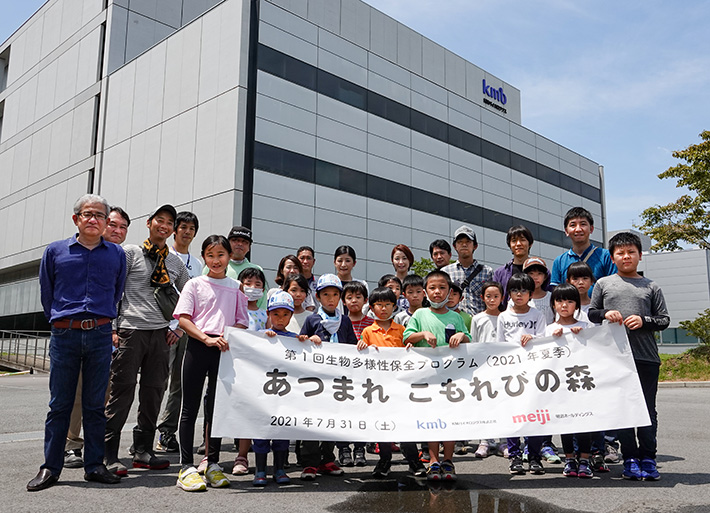
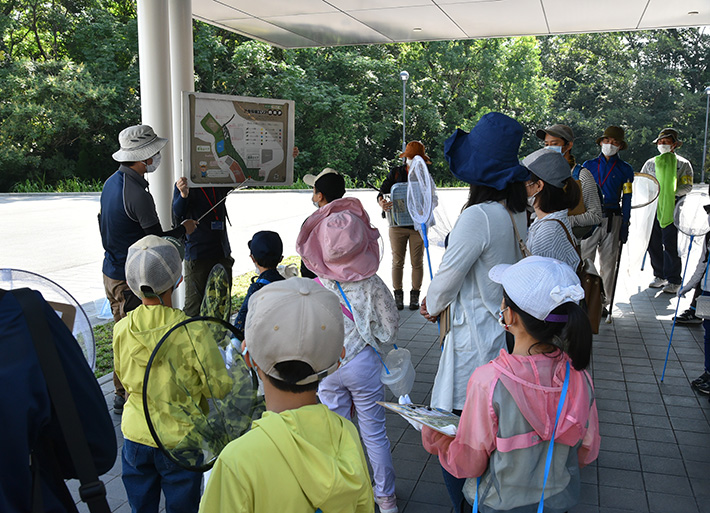
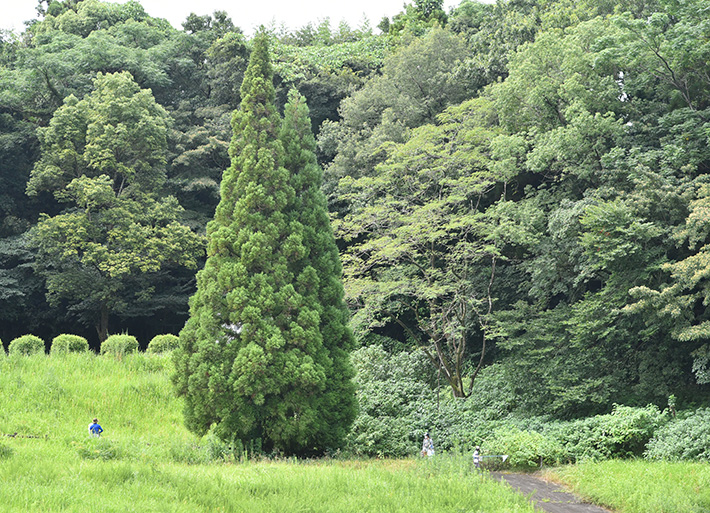
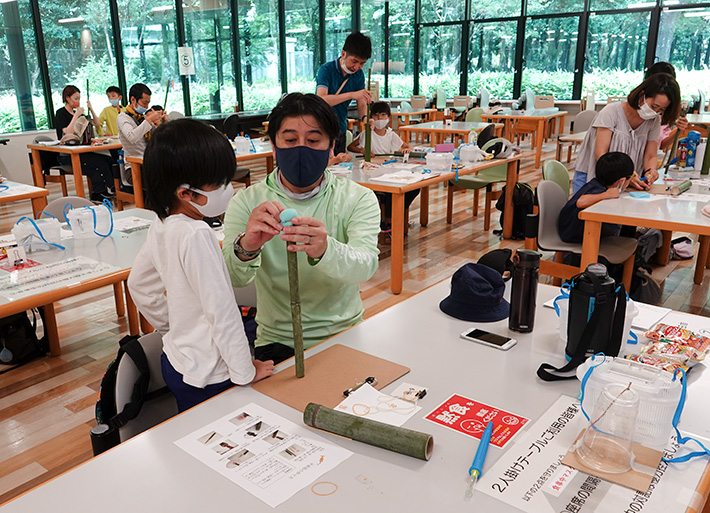
Acquisition of the SEGES "Social and Environmental Green Evaluation System Excellent Stage 3" and "Shizen-kyousei site (Site in Harmony with Nature, OECM*)"
Kumamoto Sunlight Forest was certified as "Excellent Stage 3" under the SEGES "Social and Environmental Green Evaluation System" This recognition was based on survey results commending the value of Kumamoto Sunlight Forest a green space, its relevance to the local community, and the green space conservation management system. The natural environment survey of Kumamoto Sunlight Forest was conducted by the Organization for Landscape and Urban Green Infrastructure. SEGES is an objective system that evaluates and certifies the value of green spaces owned and managed by companies, and whether these efforts contribute to society and the environment. Additionally, Kumamoto Sunlight Forest was certified as "Shizen-kyousei site (Site in Harmony with Nature)" by the Ministry of the Environment of Japan, and registered in the international database as an Other Effective area-based Conservation Measure (OECM).
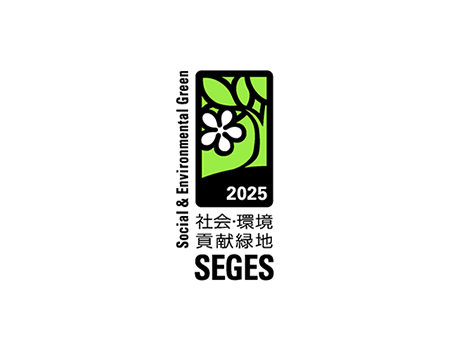
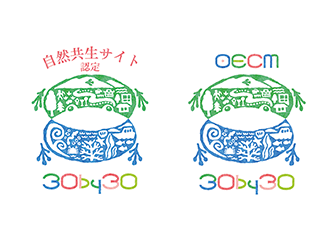
Forest Creation in Collaboration with Local Governments
Biodiversity Conservation in the Nemuro Nature Conservation Area
The Meiji Group carried out activities for the conservation of wild birds and biodiversity in collaboration with the Wild Bird Society of Japan from 2007 to 2019 on land (467 ha) that we owned in Nemuro City, Hokkaido. Through the activities, we confirmed that the populations of endangered wild birds, including Red-crowned crane and White-tailed eagle, have been maintained. Our employees provide volunteer work there twice a year, including planting trees, developing forests and watching birds, and this has helped to generate environmental awareness among employees. From 2010, the area had also been used for the environmental education of local children. We held nature observation meetings for local children and their guardians in collaboration with the Wild Bird Society of Japan and we actively participated in events with themes on wild birds held by Nemuro City.
Following the closure of a neighboring plant in 2020, we donated the natural environment conservation area to Nemuro City. However, will continue to work on biodiversity conservation activities in the area going forward in collaboration with the local society under the agreement we have concluded with Nemuro City, as we respect the significance of the activities we have engaged in.
In October 2024, employee volunteers participated in planting 500 seedlings in the Makinouchi area of Nemuro City.
Activities at Own Sites
Activities at Domestic Sites with Production Plants
We pursue activities for biodiversity conservation at domestic sites including Group companies with production plants (41sites).
| Eniwa Plant | Cleanup of Kotonihassamu River |
|---|---|
| Wakkanai Plant | Cleanup of Koetoi Coast |
| Nishi Shunbetsu Plant | Tree Planting Activities at Midorigaoka Forest Park, etc. |
| Tokachi Plant | Participation in the Flower Town Project along National Route 38 (plant management), etc. |
| Honbetsu Plant | Honbetsu Town Tree Planting Festival, etc. |
| Tohoku Plant | Nanatsumori Satoyama conservation activities (Meiji SDGs forest creation experience), etc. |
| Ibaraki Plant | Cleanup of Tomoe River tributary |
| Moriya Plant | Cleanup of Ono River riverside |
| Gunma Plant Gunma Nutritionals Plant |
Conservation Activities around Yubiso River, etc. |
| Saitama Plant | Cleanup around Central Children's Park and Furusumida River |
| Toda Plant | Todagahara Primrose Planting Activities |
| Sakado Plant | Cleanup of Koma River |
| Kanagawa Plant | Satoyama Conservation Activities |
| Nagano Cheese Plant | Cleanup of Chikuma River |
| Tokai Plant | Local Cleanup Activities |
| Aichi Plant | Cleanup of Sukatani River |
| Kyoto Plant Kyoto lactobacillus Plant |
Cleanup of the drains around the plant and weeding the surrounding area |
| Kansai Plant Kansai Ice Cream Plant Kansai Nutritionals Plant |
Cleanup of Nishikinohama Beach, etc. |
| Osaka Plant | Bamboo Forest Maintenance at Harashiroyama |
| Kurashiki Plant | Endangered species breeding and conservation activities |
| Kyushu Plant | Yame City Can and Bottle Collection Campaign (Greenbelt and River Cleanup) |
| Meiji Innovation Center | Rural Woodlands Conservation in Utsunuki Green Area |
| Donan Shokuhin Co., Ltd. | Cleanup of Kameda River |
| Meiji Chewing Gum Co., Ltd. | Cleanup of Shonai River |
| Tokai Nuts Co., Ltd. | Cleanup around Shirafuji No Sato |
| Tokai Meiji Co., Ltd. | Planting pine trees and clearing undergrowth at Asaba Coast |
| Meiji Oils and Fats Co., Ltd. | Amanogawa River Clean & Walk |
| Gunma Meiji Milk Products Co., Ltd. | Forest Conservation Activities in collaboration with NPO |
| Tochigi Meiji Milk Products Co., Ltd. | Endangered species conservation activities |
| Shikoku Meiji Co., Ltd. (Kagawa Plant, Matsuyama Plant) |
Forest Matching (forest maintenance activities) |
| Okinawa Meiji Milk Products Co., Ltd. | Coral Reef Restoration Activities in Okinawa |
| Nihon Kanzume, Inc. | Cleanup of Memuro River |
| Meiji Feed Co., Ltd. | Environmental maintenance (cleanup, weeding) in the research center and surrounding areas |
| Gifu Plant | Forest Conservation Activities in Seki City Itonuki River cleanup activities (Genji firefly conservation activities), etc. |
|---|---|
| Ashigara Research Center | Sakawa River Cleanup/Beautification, Biotope Regeneration |
| Meiji Seika Pharmatech Co., Ltd. | Participation in Odawara Medaka (endangered species) foster parent program, etc. |
| Ohkura Pharmaceutical Co., Ltd. | Cleanup of Uji River Basin (in cooperation with Uji city) |
| Headquarters and Kumamoto Production Center | Jointly held by Kumamoto Head Office/Office, Kikuchi Research Institute, Koshi Factory, and Aso Office Noyaki (Prescribed burn) on Mt. Aso Conservation of abandoned farmland Clean up of Lake Ezu Kumamoto Sunlight Forest Biodiversity Conservation Activities, etc. |
|---|---|
| Kikuchi Research Center | |
| Koshi Production Center | |
| Aso Production Center |
Activities at Overseas Sites with Production Plants
We pursue biodiversity conservation activities at the Meiji Group's overseas sites with production plants (12sites).
Meiji Pharma Spain, S.A. is carrying out tree planting activities in Las Palas, Meco, to reforest the rural area.
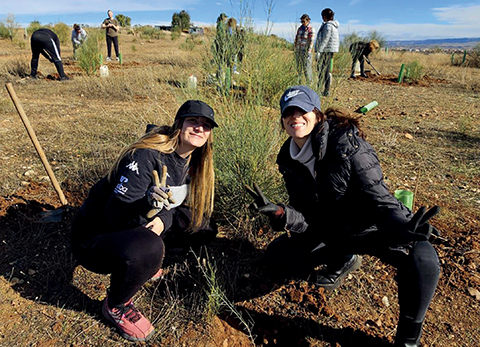
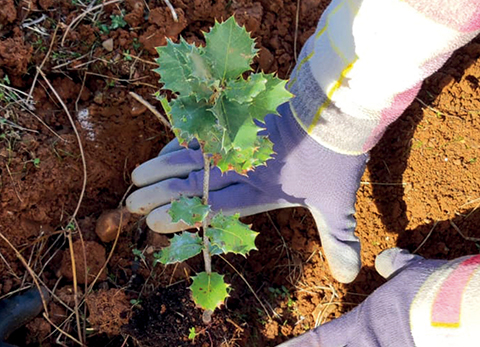
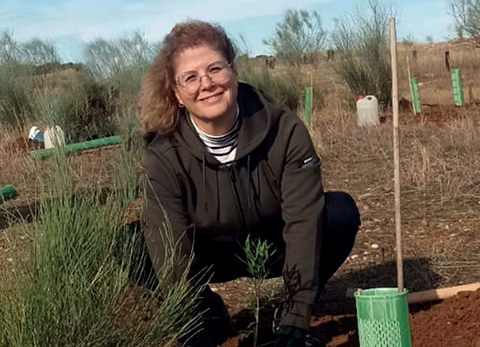
We at Medreich celebrated the world environment day with purpose and to create more awareness on the environment. Across the locations environment protection related banners were displayed.
Saplings were planted by employees to mark the importance of this very significant day. Posters were created, and employees were issued badges, environment tip cards. Employees were also encouraged to give environment related speeches to spread their knowledge on saving environments. Along with the above, employees took oath at every location for protecting environment.
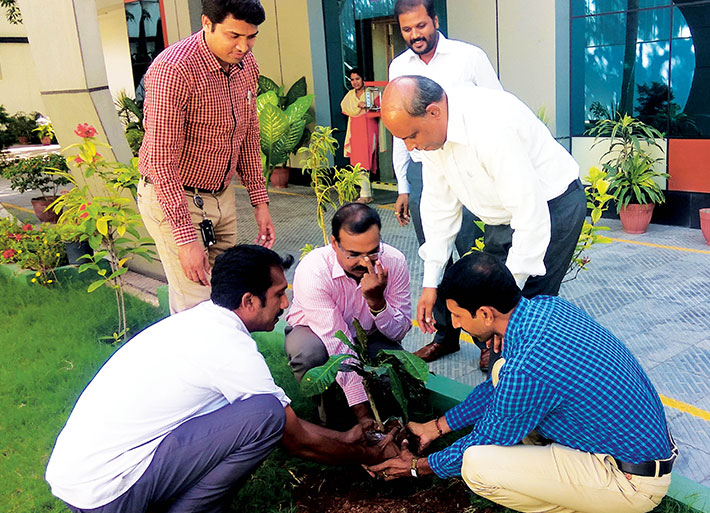
Activities in Collaboration with Local Governments
The Meiji Group's sites and companies that have production plants pursue local biodiversity conservation by participating in such activities held by local governments. The Osaka Plant of Meiji Co., Ltd. participates in the "Adopt a Forest Program," hosted by Osaka Prefecture, where wasted forests, including neglected artificial and bamboo forests, are converted into broadleaf forests for the prevention of global warming and biodiversity conservation.
Shikoku Meiji, a group company of Meiji Co., Ltd participated in the "Forest Matching - Joint Forest Development Project" hosted by the Kagawa Prefectural Government and concluded an agreement with Kagawa Prefecture, Mitoyo City and the Mitoyo City Kanda Property Ward Management Association in July 2014. They named a forest (1.1 ha) located in Yamamoto-cho, Mitoyo City as Shikoku Meiji Team Wanpaku No Mori and undertake forest development activities, including cutting bamboo and planting wild cherry trees.
Meiji Co., Ltd. Gunma Plant, Gunma Nutritionals Plant and Gunma Pharmaceuticals Plant, and Tochigi Meiji Milk Products participated in the "work for installing fences to prevent the invasion of Sika deer in Oe Marsh in Oze" implemented by Minami-Aizu Branch District Forest Office in order to reduce the damage to alpine plants, including Broad dwarf day lily, from being eaten by Sika deer. In this way, we help to secure the living environment of species and biodiversity.
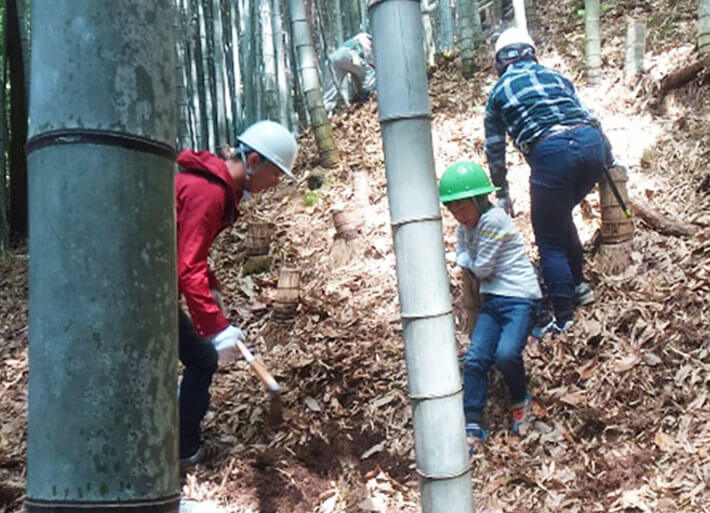
Participating in "Adopt a Forest Program" in OsakaPrefecture
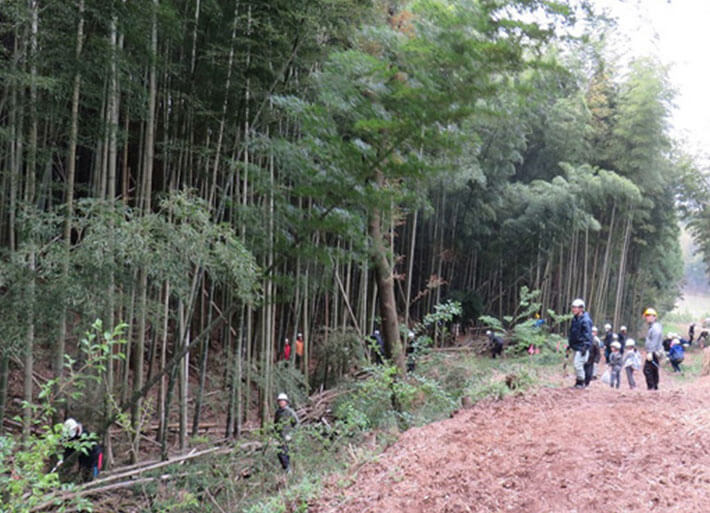
Participating in "Forest Matching Project" in Kagawa Prefecture
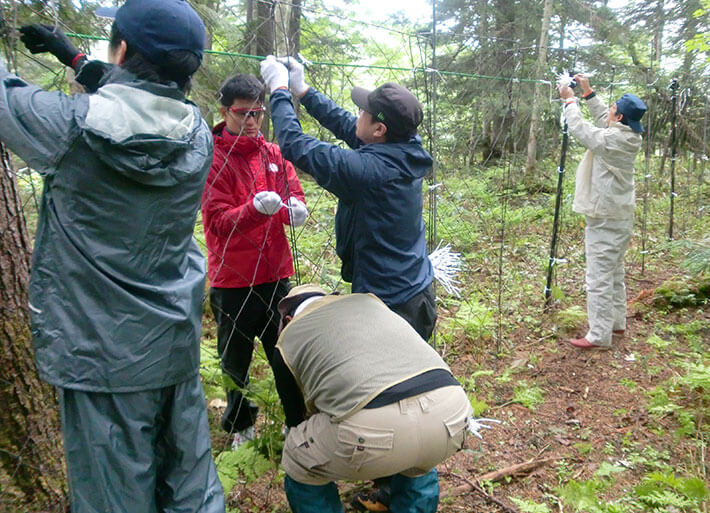
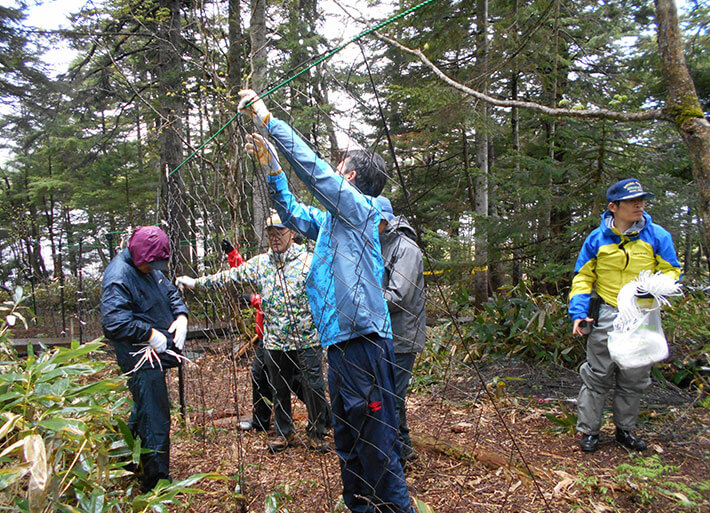
Working for installing fences to prevent the invasion of wild deer in Oe Marsh in Oze
Avoid Forest Depletion and Deforestation
Analysis of Dependency/impact of Business Activities on Nature in Line with TNFD (LEAP Approach)
Nature-related risk analysis and response in cocoa production using the LEAP approach
Utilizing the LEAP approach under the TNFD framework, we evaluated the dependency and impact of major Meiji Group cocoa production sites (13 sites) on nature, analyzed each location, and assessed risks based on the results. The results are described below. In the future, we will pursue efforts to avoid and mitigate nature-related risks by conducting gap analysis, etc., for production areas.
Relationships of dependency and impact on nature in cocoa production areas: Evaluate and Locate
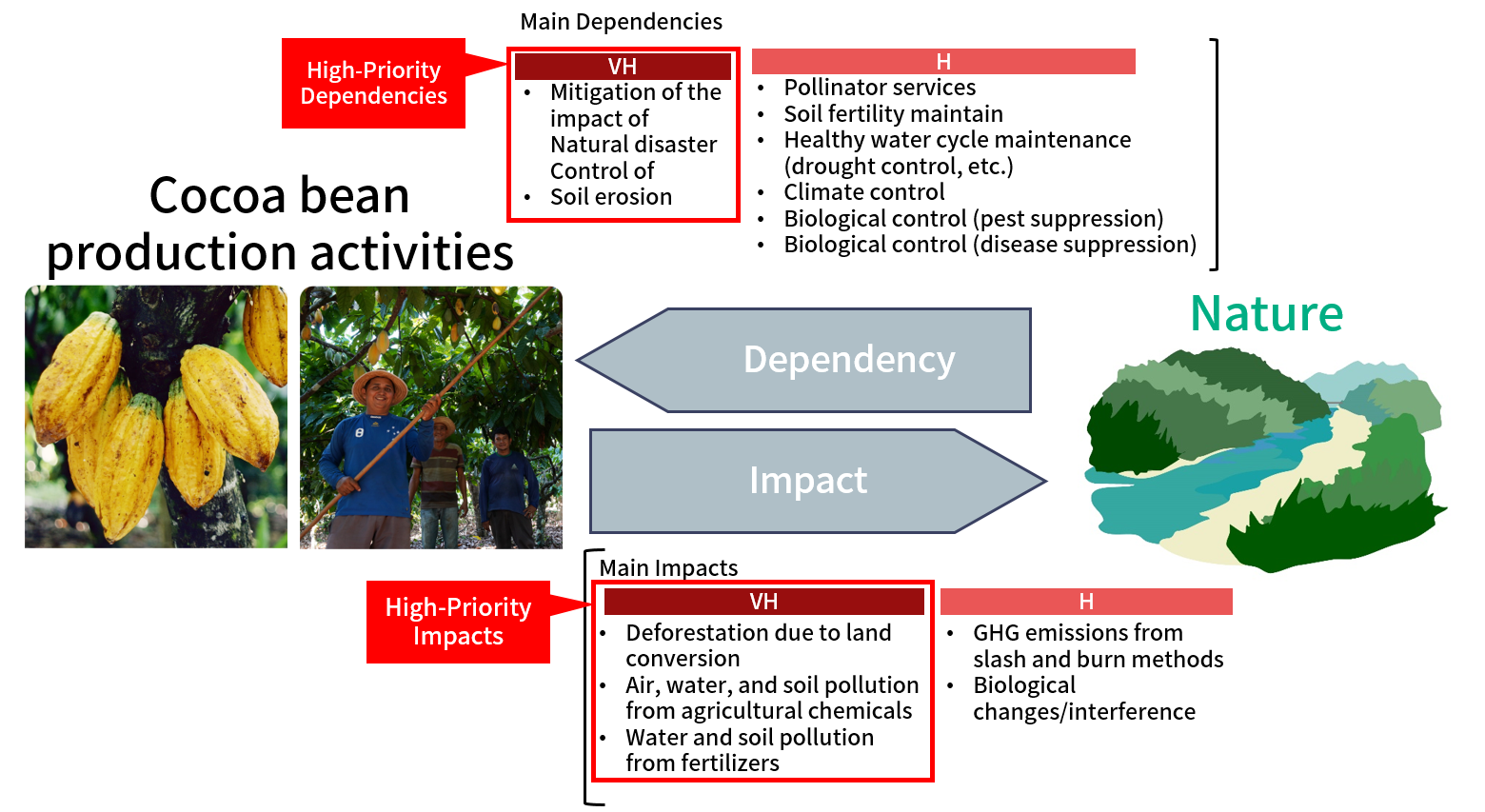
Figure Dependencies and Impacts in the Relationship Between Cocoa Cultivation and Nature
Risk analysis results by cocoa bean production area for priorities of impact/ dependency
| Impact/ Dependency1 | Impact | Dependency | |||||
|---|---|---|---|---|---|---|---|
| High priorities2 | Changes in terrestrial ecosystem usage | Air pollution | Water pollution | Soil pollution | Mitigation of the impact of natural disasters | Control of soil erosion | |
| Number of VH3-Assessed sites | 4 | 1 | 1 | 1 | 2 | 2 | |
Examples of Meiji Group nature-related risks in cocoa production: ASSESS
Risk emergence and business approaches
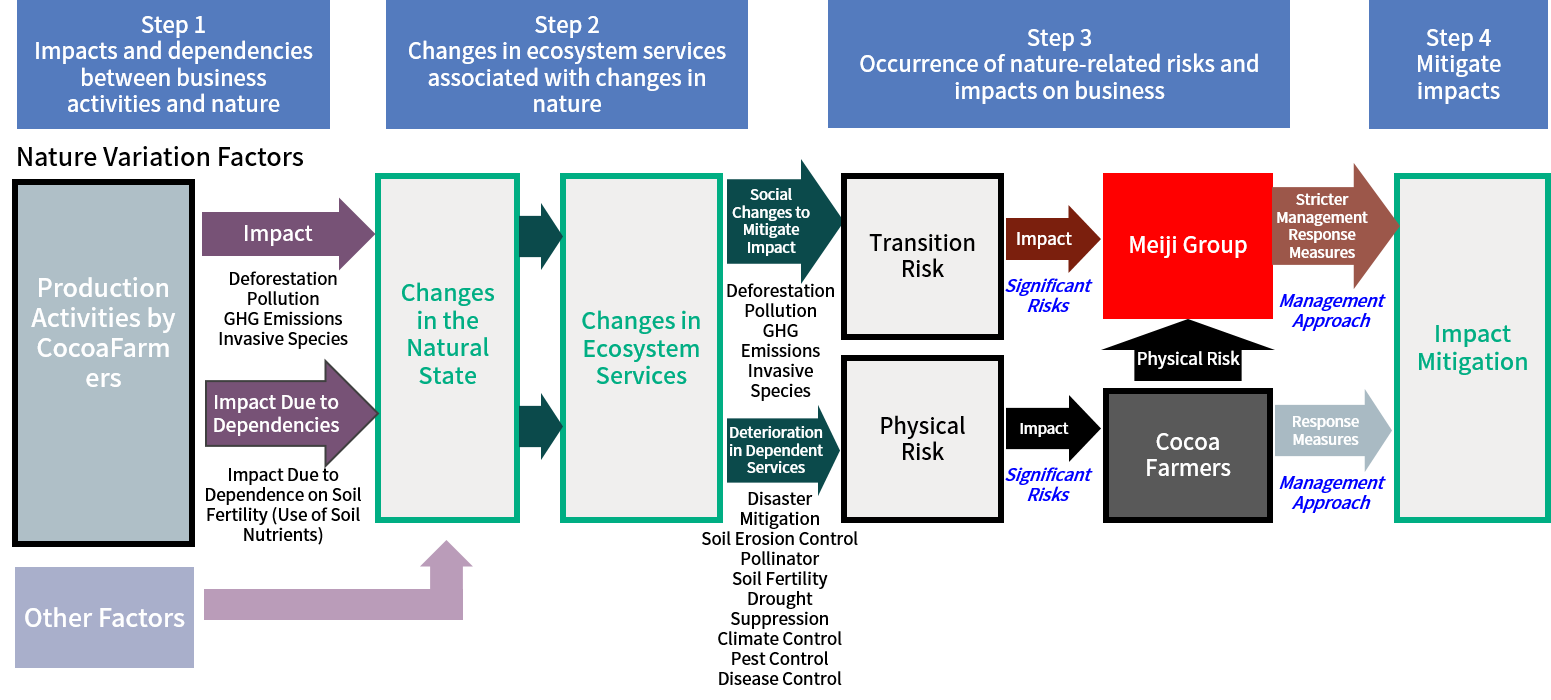
Table Linkages Among Nature-Related Dependencies, Impacts, and Risks
Impacts and dependencies in the production of cocoa beans may be a contributing factor, and the above steps may cause changes in natural conditions and ecosystem services. Such changes could create physical and transition risks that have a financial impact on the Meiji Group.
Examples of Meiji Group nature-related risks in cocoa production
| Classification | Risk | |
|---|---|---|
| Physical Risk | Acute/Chronic | Limitations on procurement due to lower yields |
| Increased procurement costs due to higher costs resulting from lower yields | ||
| Transition Risk | Regulations | Restrictions on imports and exports due to stricter regulations |
| Increased costs for procurement of environmentally friendly raw materials (certified lumber, etc.) due to stricter regulations | ||
| Increased burden of complying with new regulations (compliance with disclosure requirements) | ||
| Market | Increased ESG investment activity in response to changing investor preferences (leading to share price instability if the Company is removed from ESG investment indexes) |
|
| Increased ethical consumption due to changing consumer preferences (decrease in sales if products are not eligible as ethical consumption purchases) |
||
| Soaring procurement costs due to changes in the supply-demand balance | ||
| Technology | Increased burden in adopting new technologies | |
| Reputation | Decrease in sales due to decline in brand value | |
| Lower recruiting and employee retention rates due to declining brand value | ||
Physical risks include the possibility that cocoa farmers may not be able to continue production activities as before, and cocoa yields may decrease if ecosystem services, such as natural disaster mitigation and soil erosion control, undergo degradation. This risk could cause the Meiji Group to limit the amount of cocoa procured and experience increased procurement costs due to rising costs.
Transition risks include aspects such as tighter regulations, market changes, response to technological innovation, and reputation. Deforestation-related regulations are being implemented mainly in the EU, and considering the spread of such regulations to Japan and other factors, the Meiji Group cannot ignore potential market and reputation impacts. In addition, air, water, and soil pollution are emerging as problems in certain areas, and there are risks associated with future tightening of regulations and new rules.
Responding to the risks posed by impact and dependence on biodiversity: PREPARE
The Meiji Group established the following KPI (Meiji Sustainable cocoa Bean Procurement Ratio) for sustainable cocoa bean production. We continue efforts to avoid and reduce environmental impacts such as deforestation and pollution in cocoa production areas through Meiji Cocoa Support.
At the same time, the evaluation of the importance of nature-related risks remains only a simplified study. In addition to this evaluation, we must continue to study the actual situation on the ground in production areas and conduct scenario analysis. In the event efforts fall short, we must implement additional
Measures to avoid or mitigate nature-related risks.
Targets for our Sustainable Sourcing Initiatives
Details of Initiatives
Reference: Measures to mitigate dependency /impact on biodiversity (examples)
The following represents a portion of our efforts to mitigate biodiversity loss in terms of avoidance, reduction, regeneration, restoration, and conversion. In the future, we must conduct more detailed analyses and engage in additional initiatives to avoid or mitigate nature-related risks, as we have done in cocoa production areas.
| Mitigation (Avoid) | Procuring certified raw materials (support NDPE policy: No Deforestation, No Peat, No Exploitation; adopting wider usage of RSPO certified palm oil, etc.) Sustainable Sourcing |
| Reduce | Reducing GHG emissions in dairy farming Make Sustainable Dairy Industry |
| Regeneratte and restore: | Encouraging forest-building agriculture and agroforestry practices Efforts to Stop Deforestation |
| Transform | Invested in cocoa cell culture startup California Cultured Inc. |






